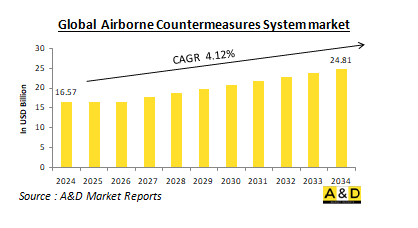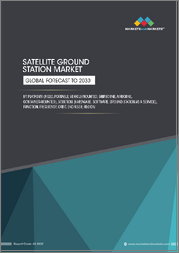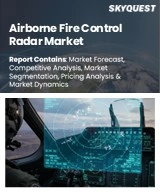
|
시장보고서
상품코드
1556131
세계의 공중 대응 시스템 시장(2024-2034년)Global Airborne Countermeasures System Market 2024-2034 |
||||||
세계의 공중 대응 시스템 시장은 2024년에 165억 7, 000만 달러로 추정되고, 예측 기간 동안 복합 연간 성장률(CAGR)은 4.12%를 나타낼 전망이며, 2034년까지 248억 1, 000만 달러로 성장할 것으로 예측됩니다.

세계 공중 대응 시스템 시장 개요
공중 대응 시스템(ACS)은 레이더 유도 미사일, 적외선 추적 무기, 기타 고급 공격 등 폭넓은 위협으로부터 자신을 보호하기 위해 군용기나 민간기에 배치되는 기술과 방법을 말합니다. 이러한 시스템은 다양한 방공 시스템과 적의 공격 메커니즘으로부터 항공기를 보호하고 적지에서 항공기의 생존에 필수적입니다. 전투기, 정찰기, 수송기, 헬리콥터 등 귀중한 공중 자산을 지키려고 하는 군에 있어서, 공중 대응의 개발과 배치는 현대의 방위 전략에 있어서 중요한 측면이 되고 있습니다. 미사일 기술과 레이더 시스템이 발전함에 따라 첨단 대책의 필요성은 전례 없이 절박하고 있습니다. 대처방법에는 레이더 재머, 적외선(IR) 플레어, 디코이, 지향성 적외선 대항조치(DIRCM) 시스템 등의 기술이 포함됩니다. 이러한 시스템은 날아오는 위협의 유도 시스템을 혼란시키거나 목표에 도달하기 전에 물리적으로 파괴함으로써 날아오는 위협을 속이거나 무력화합니다. 세계 각국이 고도화하는 위협으로부터 자국의 항공함대를 지키려고 하는 가운데, 세계의 공수대책 시장은 꾸준히 성장하고 있습니다. 지정학적 긴장 증가, 방어 예산 증가, 미사일 및 레이더 기술의 진보가 보다 고도로 통합된 대항 시스템 수요를 촉진하고 있습니다. 이러한 시스템의 적용은 전투 지역에서의 군사 작전과 분쟁 지역에서 활동하는 민간기 모두에게 매우 중요합니다.
세계의 공중 대응 시스템 시장에서의 기술의 영향
공중 대응 기술의 정세는 급속히 변화하고 있으며, 특히 센서, 소프트웨어, 전자전 능력의 쇄신에 의해 이러한 시스템의 운용 방법이 변화하고 있습니다. 이러한 진보로 대항 시스템은 보다 효율적이고 신뢰성이 높고 다양한 위협에 대처할 수 있게 되었습니다. 주요 기술 동향 중 하나는 전자전(EW) 시스템의 고도화입니다. EW 시스템을 통해 항공기는 적 무기의 레이더 신호와 전자 방사를 탐지, 분석 및 무효화할 수 있습니다. 적의 레이더를 방해하고 미사일의 유도를 방해함으로써 EW 시스템은 다른 대항 조치와 함께 레이더 유도 미사일과 적외선 유도 미사일 모두에 대한 견고한 방어 네트워크를 형성합니다. 적외선 방해(IRCM)도 특히 열 감지 미사일에 대처하는 데 진보하고 있습니다. 지향성 적외선 방해(DIRCM)와 같은 기술은 레이저를 사용하여 적외선 유도 미사일의 유도 시스템을 혼란시켜 표적을 잠그지 못하게 합니다. 이러한 시스템은 특히 적대적인 환경에서 점점 정밀하고 효과적이 되고 있습니다. 디코이 시스템은 또한 중요한 기술이며 항공기의 열과 레이더 시그니처를 모방하여 비행하는 미사일을 우회하도록 설계되었습니다. 최근의 예언 디코이의 발전으로 속도와 효율성이 향상되어 레이더 유도 위협에 매우 효과적입니다. AI, ML 구동식의 자율형 대항 시스템은 현재 인간의 개입 없이 실시간으로 위협을 탐지하고 대응할 수 있습니다. 이 자동화는 반응 시간을 단축시키고, 이는 큰 위험을 수반하는 전투 시나리오에서 중요한 요소가 됩니다. 또한, 최신 항공기는 레이더와 레이저 경고 수신기, 미사일 접근 경고 시스템, 방해 시스템 등 여러 대항 기술을 하나의 통합 유닛에 통합하는 통합 방어 제품군을 갖추고 있습니다. 이러한 통합 시스템은 종합적인 방어를 제공하여 항공기가 분쟁 환경에서도 안전하게 작동할 수 있도록 합니다.
세계 공중 대응 시스템 시장의 주요 촉진요인
몇 가지 중요한 요인, 특히 군용기와 민간기 모두가 직면하는 위협의 진화와 대항 시스템의 효능을 높이는 기술 진보 등이 세계 공중 대응 시장의 성장을 가속하고 있습니다. 지정학적 긴장의 고조는 중요한 촉진요인이며, 중동, 동유럽, 남중국해 등의 지역이 잠재적인 분쟁 지역이 되고 있습니다. 이러한 긴장은 잠재적인 충돌에서 항공 우세와 항공기의 생존을 보장하기 위해 선진적인 공중 대응을 포함한 방어 갱신에 많은 투자를 촉구하고 있습니다. 또 다른 중요한 요소는 미사일 기술의 급속한 진보입니다. 극초음속 미사일이나 차세대 지대공 미사일의 개발에 의해 보다 빠르고, 보다 민첩하고, 보다 정확하게 위협을 무력화할 수 있는 최첨단의 대항 시스템이 요구되고 있습니다. 왜냐하면 미사일의 능력이 진화함에 따라 효과적으로 대항하기 위해서는 대항시스템도 보조를 맞추어야 하기 때문입니다. 북미, 아시아태평양, 유럽을 중심으로 한 국방 지출 증가가 공중 대응 시장의 성장을 더욱 뒷받침하고 있습니다. 방위 예산이 증가함에 따라 군는 종합적인 방어 능력을 강화하기 위해 전자전 기술과 첨단 적외선 방해와 같은 보다 정교한 시스템에 투자하고 있습니다. 또한 항공기의 생존성에 초점을 맞추는 것도 중요한 우선순위입니다. 특히 분쟁 지역에서는 항공기의 손실이 작전 및 전략에 심각한 영향을 미칠 수 있습니다. 이 때문에 적대적인 환경에서도 항공기가 생존할 수 있도록 최신의 대항 기술을 장비하는 것이 중시되게 되어 있습니다. 마지막으로, 전자전, 적외선 대항, 데코이 시스템에 있어서 끊임없는 기술 진보에 의해 공중 대응은 보다 효과적으로 되고 있습니다. 위협을 자율적으로 탐지하고 대항할 수 있는 AI 탑재 시스템의 통합은 대항 부품의 소형화와 함께 이러한 기술을 보다 광범위한 항공기에 배치할 수 있게 하여 시장 성장을 더욱 촉진하고 있습니다.
세계의 공중 대응 시스템 시장의 지역별 동향
공중 대응 시스템의 채용, 개발 상황은 지역에 따라 다르고, 지역 고유의 지정학적 과제나, 방위상의 우선사항, 기술력에 의해 좌우되고 있습니다. 북미, 특히 미국은 선진적인 전자전, 적외선 방해 기술에 많은 투자를 하고 시장을 선도하고 있습니다. Lockheed Martin, Northrop Grumman, Raytheon 등 미국의 국방 수탁업자가 기술 혁신의 최전선에 서서 미 공군, 해군, 육군용으로 최첨단 시스템을 개발하고 있습니다. 군용기 함대의 근대화는 이 지역에서 새로운 대항 조치 수요의 주요 추진력입니다. 유럽에서는 영국, 독일, 프랑스 등의 국가들도 방위력 강화의 일환으로 공중 대응에 많은 투자를 하고 있습니다. 러시아의 위협 증가와 영공 안전 확보의 필요성으로 인해 유럽 국가들은 항공기의 생존성에 중점을 두고 있습니다. 유럽 연합(EU)의 상설 협력(PESCO)과 같은 협력적인 방어 노력은 첨단 대책 시스템에 대한 투자를 더욱 자극하고 있습니다. 아시아태평양에서는 중국, 인도, 일본 등의 국가들이 특히 남중국해와 인도와 중국의 국경을 따라 지정 학적 긴장 증가에 대응하여 군비의 근대화를 진행하고 있기 때문에 공중 대응 시장이 크게 성장하고 있습니다. 이 지역의 공군의 급속한 확대는 잠재적인 분쟁에서 항공기의 생존성을 높이기 위한 첨단 대책 수요를 촉진하고 있습니다. 중동에서는 사우디아라비아, 아랍에미리트(UAE)(UAE), 이스라엘 등의 국가들이 반정부세력과 지역의 적대세력에 의한 미사일 위협으로부터 자국의 항공함대를 지키기 위해 공수대책에 많은 투자를 하고 있습니다. 시리아 예멘과 같은 지역에서 현재 진행 중인 분쟁은 군용기와 민간기 모두에 대한 고급 대항 시스템의 중요성을 돋보이게 합니다. 아프리카는 시장 규모가 작은 것, 지역 분쟁이나 적대적 환경에서 항공 자산의 안전 확보의 필요성 때문에 대항 조치에 대한 수요가 증가하고 있습니다.
공중 대응 시스템의 주요 프로그램
미국 해군은 세계에서 가장 정교한 무선 주파수(RF) 대항 수단 중 하나인 듀얼 밴드 디코이(DBD) 개발에 BAE Systems를 선택했습니다. DBD는 전투기에 대한 적의 공격을 방지하도록 설계된 최첨단 RF 자기 방어 재머입니다. 미국 해군은 미사일 및 기타 위협으로부터 P-8A Poseidon 멀티미션 해상기를 보호하는 강화된 대항 포드를 제공하기 위해 BAE 시스템즈에 9, 500만 달러의 계약을 주문했습니다.
미국 국무부는 추정 5억 달러의 비용으로 이탈리아 정부에 대한 항공 정보, 감시, 정찰, 전자전(AISREW) 임무 시스템 및 관련 기기를 장비한 Gulfstream G550 항공기의 대외 군사 매각 가능성을 승인했습니다. 오늘, 국방안보협력국은 이 잠재적 거래에 대해 경고하는 필요한 증명서를 의회에 제출했습니다.
목차
공중 대응 시스템 시장 : 보고서 정의
공중 대응 시스템 시장 내역
- 용도별
- 지역별
- 유형별
공중 대응 시스템 시장 분석(향후 10 년간)
공중 대응 시스템 시장 시장 기술
세계 공중 대응 시스템 시장 예측
공중 대응 시스템 시장 : 지역별 동향과 예측
- 북미
- 촉진, 억제요인, 과제
- PEST 분석
- 시장 예측과 시나리오 분석
- 주요 기업
- 공급자 계층의 상황
- 기업 벤치마킹
- 유럽
- 중동
- 아시아태평양
- 남미
공중 대응 시스템 시장 : 국가별 분석
- 미국
- 방어 계획
- 최신 동향
- 특허
- 이 시장의 현재 기술 성숙 수준
- 시장 예측과 시나리오 분석
- 캐나다
- 이탈리아
- 프랑스
- 독일
- 네덜란드
- 벨기에
- 스페인
- 스웨덴
- 그리스
- 호주
- 남아프리카
- 인도
- 중국
- 러시아
- 한국
- 일본
- 말레이시아
- 싱가포르
- 브라질
공중 대응 시스템 시장 : 시장 기회 매트릭스
공중 대응 시스템 시장 : 조사에 관한 전문가의 견해
결론
Aviation and Defense Market Reports 정보
BJH 24.09.24The Global Airborne Countermeasures System Market is estimated at USD 16.57 billion in 2024, projected to grow to USD 24.81 billion by 2034 at a Compound Annual Growth Rate (CAGR) of 4.12% over the forecast period 2024-2034

Introduction to Global Airborne Countermeasures System Market:
Global Airborne Countermeasures Systems (ACS) refer to technologies and techniques deployed on military and civilian aircraft to protect against a wide range of threats, including radar-guided missiles, infrared-seeking weapons, and other sophisticated attacks. These systems are essential for the survivability of aircraft in hostile environments, offering protection against various air defense systems and enemy attack mechanisms. The development and deployment of airborne countermeasures have become a critical aspect of modern defense strategies as militaries seek to protect valuable airborne assets such as fighter jets, surveillance planes, transport aircraft, and helicopters. With advancements in missile technology and radar systems, the need for advanced countermeasures is more pressing than ever. Countermeasures can include technologies such as radar jammers, infrared (IR) flares, decoys, and Directed Infrared Countermeasures (DIRCM) systems. These systems either deceive or neutralize incoming threats by disrupting their guidance systems or physically destroying them before they can hit their target. The global market for airborne countermeasures has been growing steadily as countries around the world seek to protect their air fleets from increasingly sophisticated threats. Rising geopolitical tensions, growing defense budgets, and advancements in missile and radar technologies are driving the demand for more advanced and integrated countermeasure systems. The application of these systems is crucial for both military operations in combat zones and civilian aircraft operating in areas of conflict.
Technology Impact in Global Airborne Countermeasures System Market:
The technological landscape of airborne countermeasures is rapidly advancing, with innovations in sensors, software, and electronic warfare capabilities transforming how these systems operate. These advancements are making countermeasure systems more efficient, reliable, and capable of addressing diverse threats. One of the key technological trends is the sophistication of Electronic Warfare (EW) systems, which now allow aircraft to detect, analyze, and counteract radar signals and electronic emissions from enemy weapons. By jamming enemy radars and disrupting missile guidance, EW systems work alongside other countermeasures to form a robust defense network against both radar-guided and infrared-guided missiles. Infrared Countermeasures (IRCM) are also advancing, especially in dealing with heat-seeking missiles. Technologies like Directed Infrared Countermeasures (DIRCM) use lasers to confuse the guidance systems of infrared-seeking missiles, preventing them from locking onto their targets. These systems are becoming increasingly precise and effective, particularly in hostile environments. Decoy systems are another critical technology, designed to divert incoming missiles by mimicking the heat or radar signatures of aircraft. Recent advancements in towed decoys have improved their speed and efficiency, making them highly effective against radar-guided threats. Autonomous countermeasure systems, driven by artificial intelligence and machine learning, are now capable of detecting and responding to threats in real-time without human intervention. This automation reduces reaction time, a critical factor in high-stakes combat scenarios. Additionally, modern aircraft are being equipped with integrated defense suites that combine multiple countermeasure technologies-such as radar and laser warning receivers, missile approach warning systems, and jamming systems-into a single, cohesive unit. These integrated systems offer comprehensive protection, enabling aircraft to operate safely in contested environments.
Key Drivers in Global Airborne Countermeasures System Market:
Several key factors are driving the growth of the global airborne countermeasures market, primarily in response to evolving threats faced by both military and civilian aircraft, as well as advancements in technology that are enhancing the effectiveness of countermeasure systems. Rising geopolitical tensions are a significant driver, with regions such as the Middle East, Eastern Europe, and the South China Sea being areas of potential conflict. These tensions have prompted nations to invest heavily in defense upgrades, including advanced airborne countermeasures, to ensure air superiority and aircraft survivability in potential confrontations. Another key factor is the rapid advancement in missile technology. The development of hypersonic and next-generation surface-to-air missiles has created a demand for cutting-edge countermeasure systems capable of neutralizing these faster, more agile, and precise threats. As missile capabilities evolve, countermeasure systems must also keep pace to effectively counteract them. Increased defense spending, particularly in North America, Asia-Pacific, and Europe, has further fueled the growth of the airborne countermeasures market. With larger defense budgets, militaries are investing in more sophisticated systems, such as electronic warfare technologies and advanced infrared countermeasures, to enhance their overall defensive capabilities. The focus on aircraft survivability has also become a critical priority. Militaries recognize the strategic importance of protecting valuable aircraft assets, particularly in conflict zones, where the loss of an aircraft could have significant operational and strategic repercussions. This has led to a growing emphasis on equipping aircraft with the latest countermeasure technologies to ensure their survival in hostile environments. Finally, continuous technological advancements in electronic warfare, infrared countermeasures, and decoy systems are making airborne countermeasures more effective. The integration of AI-powered systems that can autonomously detect and counter threats, coupled with the miniaturization of countermeasure components, is enabling these technologies to be deployed on a broader range of aircraft, further driving market growth.
Regional Trends in Global Airborne Countermeasures System Market:
The adoption and development of airborne countermeasures systems vary across regions, shaped by unique geopolitical challenges, defense priorities, and technological capabilities. North America, particularly the United States, leads the global market, with significant investments in advanced electronic warfare and infrared countermeasure technologies. U.S. defense contractors like Lockheed Martin, Northrop Grumman, and Raytheon are at the forefront of innovation, developing cutting-edge systems for the U.S. Air Force, Navy, and Army. The modernization of military aircraft fleets is a key driver of demand for new countermeasures in this region. In Europe, countries such as the U.K., Germany, and France are also heavily investing in airborne countermeasures as part of their efforts to enhance defense capabilities. The increasing threat from Russia and the need to secure airspace have prompted European nations to focus on aircraft survivability. Collaborative defense efforts like the European Union's Permanent Structured Cooperation (PESCO) are further stimulating investments in advanced countermeasure systems. The Asia-Pacific region is experiencing significant growth in the airborne countermeasures market, with countries like China, India, and Japan modernizing their military forces in response to rising geopolitical tensions, especially in the South China Sea and along the India-China border. The rapid expansion of air forces in the region is driving demand for advanced countermeasures to enhance aircraft survivability in potential conflicts. In the Middle East, nations such as Saudi Arabia, the UAE, and Israel are investing heavily in airborne countermeasures to protect their air fleets from missile threats posed by insurgent groups and regional adversaries. Ongoing conflicts in Syria, Yemen, and other parts of the region highlight the importance of advanced countermeasure systems for both military and civilian aircraft. While Africa represents a smaller market, demand for countermeasures is increasing due to regional conflicts and the need to safeguard air assets in hostile environments.
Key Airborne Countermeasure Programs:
The U.S. Navy has chosen BAE Systems to develop Dual Band Decoy (DBD), one of the world's most sophisticated radio frequency (RF) countermeasures. DBD is a
state-of-the-art RF self-protection jammer designed to prevent enemy attacks on fighter jets.The United States Navy has awarded BAE Systems a $95 million contract to provide enhanced countermeasure pods that would shield the P-8A Poseidon Multi-Mission Maritime Aircraft against missiles and other threats.
At an estimated cost of $500 million, the State Department has determined that a potential Foreign Military Sale of Gulfstream G550 aircraft equipped with Airborne Intelligence,Surveillance, Reconnaissance, and Electronic Warfare (AISREW) mission systems and related equipment to the Government of Italy is authorized. Today, the Defense Security Cooperation Agency provided Congress with the necessary certification alerting them to this potential transaction.
Table of Contents
Airborne Countermeasures System Market Report Definition
Airborne Countermeasures System Market Segmentation
By Application
By Region
By Type
Airborne Countermeasures System Market Analysis for next 10 Years
The 10-year Airborne Countermeasures System Market analysis would give a detailed overview of Airborne Countermeasures System Market growth, changing dynamics, technology adoption overviews and the overall market attractiveness is covered in this chapter.
Market Technologies of Airborne Countermeasures System Market
This segment covers the top 10 technologies that is expected to impact this market and the possible implications these technologies would have on the overall market.
Global Airborne Countermeasures System Market Forecast
The 10-year Airborne Countermeasures System Market forecast of this market is covered in detailed across the segments which are mentioned above.
Regional Airborne Countermeasures System Market Trends & Forecast
The regional Airborne Countermeasures System Market trends, drivers, restraints and Challenges of this market, the Political, Economic, Social and Technology aspects are covered in this segment. The market forecast and scenario analysis across regions are also covered in detailed in this segment. The last part of the regional analysis includes profiling of the key companies, supplier landscape and company benchmarking. The current market size is estimated based on the normal scenario.
North America
Drivers, Restraints and Challenges
PEST
Market Forecast & Scenario Analysis
Key Companies
Supplier Tier Landscape
Company Benchmarking
Europe
Middle East
APAC
South America
Country Analysis of Airborne Countermeasures System Market
This chapter deals with the key defense programs in this market, it also covers the latest news and patents which have been filed in this market. Country level 10 year market forecast and scenario analysis are also covered in this chapter.
US
Defense Programs
Latest News
Patents
Current levels of technology maturation in this market
Market Forecast & Scenario Analysis
Canada
Italy
France
Germany
Netherlands
Belgium
Spain
Sweden
Greece
Australia
South Africa
India
China
Russia
South Korea
Japan
Malaysia
Singapore
Brazil
Opportunity Matrix for Airborne Countermeasures System Market
The opportunity matrix helps the readers understand the high opportunity segments in this market.
Expert Opinions on Airborne Countermeasures System Market Report
Hear from our experts their opinion of the possible analysis for this market.
Conclusions
About Aviation and Defense Market Reports



















